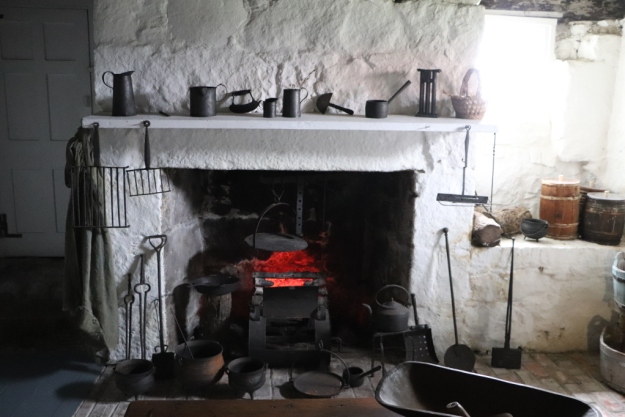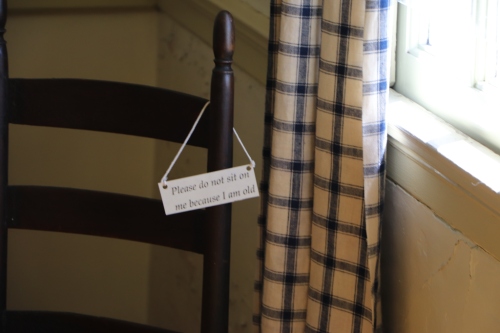By Erin Isaac
The thoughts and sentiments shared in this essay are my own and do not represent the Nova Scotia Museum or Shelburne Historical Society.
The Ross-Thomson House & Store Museum, in Shelburne, NS, has always been known as a site of enslavement in this community. Most people around here reference this by speaking about a pair of leg shackles that were once in the basement—“do you know, there were shackles in the basement?” Like many 18th-century Maritime communities, Shelburne’s early economy was inextricably tied to the institution of slavery—through the goods they imported, the buyers for goods they produced, and the actual labour of enslaved Nova Scotians. But even as many of our communities have houses that are remembered as enslaved spaces, like Ross-Thomson House, it is my impression that this is where (for many of us) our curiosity ends. There is a simultaneous impulse to remember shackles in the cellar and to distance ourselves from their implications.
In Shelburne, people lower their voices when they speak to me about slavery. I’ve been working this summer as the Renewal Coordinator for the Ross-Thomson House & Store Museum, a role that has placed me at the centre of debates about how or if Shelburne’s history of enslavement should be told. People seem generally comfortable with the museum sharing the story of Catherine Edwards, who escaped bondage at Ross-Thomson House and secured her freedom in Halifax in October 1806. In fact, I haven’t heard anyone disagree with the importance of making this history a part of the Ross-Thomson House & Store Museum. But questions about how her story should be told and how much the interpretation at Ross-Thomson House & Store should explore enslavement in Shelburne generally are hotter.

Should we place shackles on the wall where they were said to be in the 1970s according to community lore? Should we put on display the myriad ways free and enslaved Black labour disproportionately benefitted white settlers? Do we examine the ways the white and Black members of our community shared space or didn’t in colonial Shelburne? Do we interrogate the intergenerational effects of this history? Do we, as an exhibit team consisting of white-presenting staff and researchers, have any business telling this story?
For now, I have more questions than answers, more ideas than implementation strategies. The way the renewed museum approaches this history needs to acknowledge harm, tenacity, and legacy. It also needs to consider the needs of this community and the museum’s obligation to historical truth in the face of deeply embedded historical myth. Plans must also respect the museum’s long standing in Shelburne, community attachment to the building as it is, and hesitation about changing a much beloved historic site.
This is why I’ve been out in the field, doing community outreach. I’m promoting a survey looking for feedback on the Ross-Thomson Renewal Project and some of the changes we are considering, but I’m also raising awareness about this history and confronting criticisms of the project. To be clear, I’ve only received one direct criticism and the vast majority of conversations I’ve had with community members have been positive and supportive. But I’ve heard rumblings that indicate to me that I’m not hearing from everyone and that even those who support the project in principle are hesitant to make big changes all at once.

People worry that the renewal will replace the stories of white Shelburnians with those of enslaved Blacks. These respondents do not realise that history, unlike its telling, is not segregated. Some worry that incorporating Black history at the museum would mean pillorying the Ross brothers (who built the House & Store in 1785/7) when their actions were normal in that time. They do not realise that to responsibly tell this history the museum must demonstrate the regularity of enslavement in colonial Shelburne and the systems that made racial disparity the “status quo.” These concerns are born of misunderstanding and myth, more (in my opinion) than they are from conscious racism.
It is a common misconception among those of us “from away,” and even some locals, that Shelburne was a white settlement in the colonial period. Writings about the town and the way its history has been represented to the public have created and bolstered this myth. Because the community lies so near to Birchtown, which was at its height the largest free Black community outside of Africa, there has been a tendency to imagine Birchtown as the “Black town” and Shelburne as the “white town.”
The truth is that many free and enslaved Black people lived in Shelburne too and that white, Black, and Indigenous people all congregated here for work or to conduct business. My research, in addition to the excellent work of scholars like Amani Whitfield, Sarah Chute, and Graham Nickerson, seek to give statistics and names to these persons who have been unrecognised and unnamed in other histories.
Black history in Shelburne is nuanced and often more gray than it is black or white. This makes it hard to interpret in the brief, often insufficient encounters we have with museum patrons. It is harder when those patrons arrive with little context for Black freedom in Shelburne, let alone Black bondage, as is often the case with American visitors. Shelburne is lucky to have the Black Loyalist Heritage Centre only 15 minutes up the road from Ross-Thomson House & Store, a space where the Black loyalist experience is interpreted, but even focusing interpretation mainly on enslavement in Shelburne is messier than one might think.
 A proportion of Shelburne’s Black residents were enslaved or indentured, a distinction from free servants that is not often discernable in archival records except in cases where bills of sale or ownership transfers survive. 16 people were directly listed in the Book of Negroes as property of the Port Roseway Associate members, loyalists who landed in Shelburne after the American Revolution and are generally regarded as the town’s founders. There were without doubt hundreds more enslaved in Shelburne. Amani Whitfield points out that a majority of the 1,312 “servants” were in likely unfree in some form, be it enslaved, indentured, or otherwise.[1] Even for those who came by choice, it was probably not their first choice. After all, only a portion of those names recorded in the Book of Negroes were free and freedom was not without caveats.
A proportion of Shelburne’s Black residents were enslaved or indentured, a distinction from free servants that is not often discernable in archival records except in cases where bills of sale or ownership transfers survive. 16 people were directly listed in the Book of Negroes as property of the Port Roseway Associate members, loyalists who landed in Shelburne after the American Revolution and are generally regarded as the town’s founders. There were without doubt hundreds more enslaved in Shelburne. Amani Whitfield points out that a majority of the 1,312 “servants” were in likely unfree in some form, be it enslaved, indentured, or otherwise.[1] Even for those who came by choice, it was probably not their first choice. After all, only a portion of those names recorded in the Book of Negroes were free and freedom was not without caveats.
The Book of Negroes is often misunderstood as a register of Black loyalists who claimed freedom under Dunmore’s Proclamation during the American Revolution. It is in fact a muster of all racialised individuals (free, enslaved, or ambiguously designated) who departed New York with the British when they evacuated. As historian Carolyn Troxler has shown, one’s freedom was not always protected in Shelburne and many free Blacks were re-enslaved in Nova Scotia.
This history’s complexity is part of the reason that consultation with community members has been my priority this summer, before formal plans for the interpretive renewal at Ross-Thomson House & Store Museum can be made. Plans should also rely on expert opinions on how this history can be incorporated respectfully and meaningfully, and I hope some of you fair readers will fill out the survey. While it is a truth universally acknowledged that every choice will produce fans and foes, the choices made in the interpretive renewal need to be reflective of current scholarship, historical truth, and considerate of community members who have emotional ties to this site.
It would be unrealistic to ask this community to deconstruct every myth or lie they’ve been told all at once. But these are conversations we need to have. Progress, like history, isn’t linear. Time doesn’t guarantee improvement. The Ross-Thomson Renewal Project won’t fix historical wrongdoings or injustices. This is, on the scale of things, one small museum in one small Maritime community. But it’s past time to talk about them and reincorporate our whole history into Ross-Thomson House & Store. Enslavement is a part of our history—it’s not one-sided.
If you or someone you know works in history or heritage and has expertise in Black Canadian history, please consider filling out our survey. It is available until August 31, 2023. If you are from Shelburne County or have visited the Ross-Thomson House & Store museum before, we also encourage your input.
Erin Isaac is a PhD candidate at Western University. You can learn more about the interpretive renewal project here. You can learn more about Erin’s work at historianostra.ca.
[1] Harvey Amani Whitfield, North to Bondage: Loyalist Slavery in the Maritimes (Vancouver: UBC Press, 2016), 12.
All images by Erin Isaac.
This work is licensed under a Creative Commons Attribution-NoDerivatives 4.0 International License. Blog posts published before October 28, 2018 are licensed with a Creative Commons Attribution-NonCommercial-ShareAlike 2.5 Canada License.